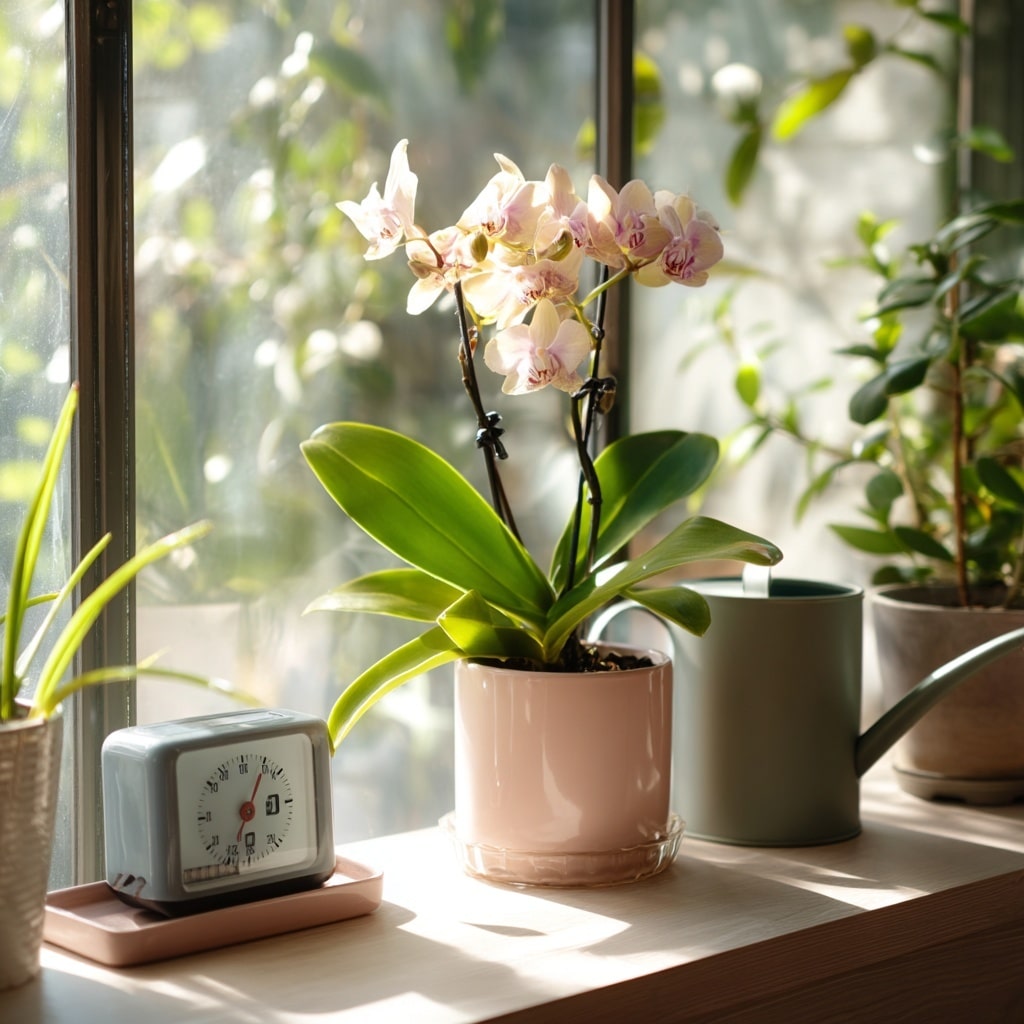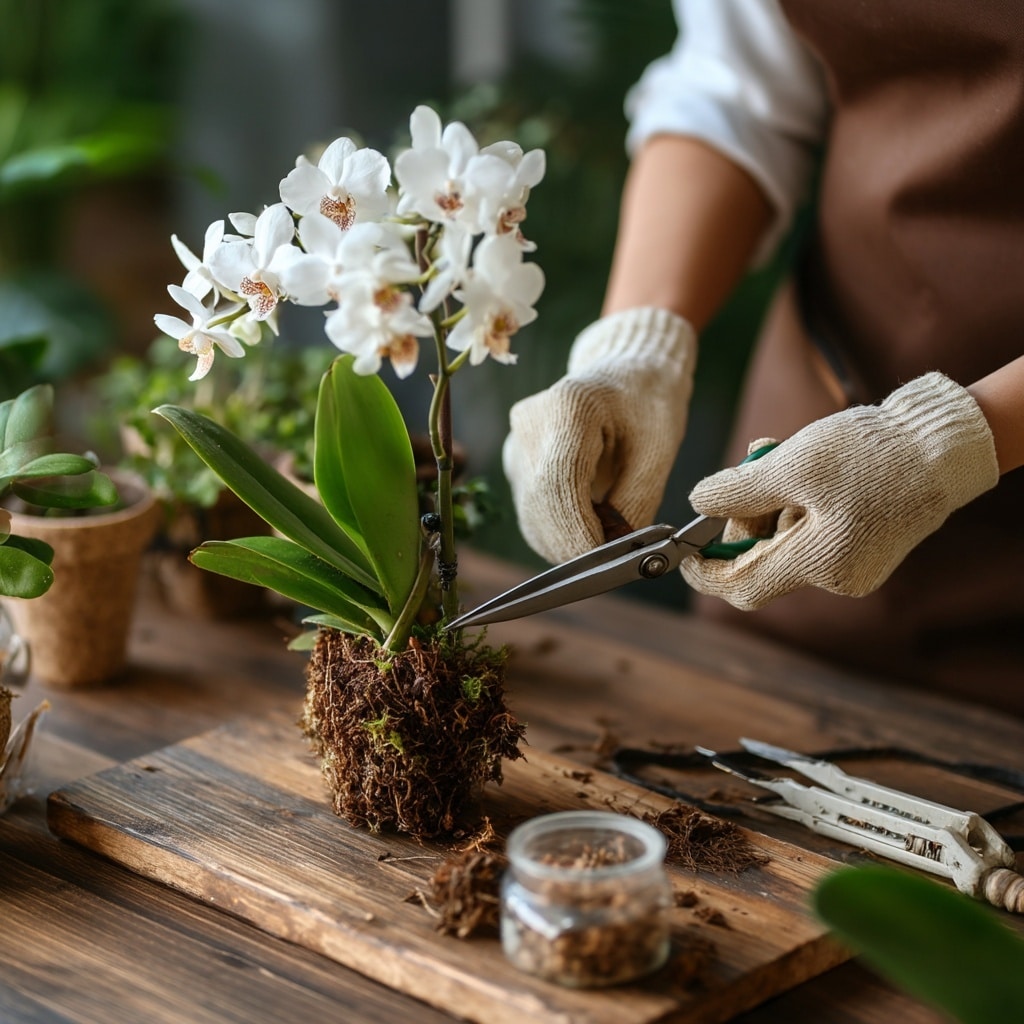Orchid care doesn’t end when the last bloom falls. For many plant lovers, the real challenge begins when trying to coax an orchid into growing a new flower spike. While these exotic beauties can appear delicate, with the right environment and a little know-how, they’re surprisingly resilient. Encouraging your orchid to rebloom requires patience, consistency, and a clear understanding of its growth cycle. In this guide, you’ll learn the proven methods to help your orchid thrive and produce new spikes naturally — without guesswork or gimmicks.
Table of Contents
Understanding the Growth Cycle of Orchids
To help your orchid grow a new spike, it’s important to first understand how its natural life cycle works. Orchids don’t bloom year-round. Instead, they follow a rhythm of active growth and dormancy, much like many other flowering plants.
Most common orchids — including the popular Phalaenopsis — enter a resting phase during the winter. During this time, your plant may appear inactive, but it’s actually conserving energy and preparing for the next burst of growth.
Come spring, your orchid reawakens. Warmer temperatures and longer daylight hours signal the plant to grow new leaves, roots, and eventually — with the right care — a fresh flower spike. Timing your care to match these seasonal patterns gives your orchid the best chance to rebloom year after year.
Provide Proper Growing Conditions

Creating the ideal environment is essential if you want your orchid to produce a healthy new spike. While orchids can adapt to many indoor settings, they flourish best under very specific conditions:
Light: Bright but Indirect
Orchids crave light, but direct sun can scorch their leaves. Place your orchid near an east- or west-facing window, where it receives gentle, filtered sunlight. A sheer curtain can help soften harsh rays while still giving the plant what it needs.
Temperature: Keep It Balanced
Daytime temps between 60–80°F and nighttime temps between 50–70°F mimic the orchid’s native tropical habitat. Avoid placing your plant near vents, drafty windows, or heat sources, as temperature swings can delay spike formation.
Humidity: Orchids Love Moist Air
Aim for 40–60% humidity. If your home is dry, especially in winter, try using a humidity tray (a shallow dish filled with water and pebbles under the pot) or run a small humidifier nearby. Bathrooms with natural light are also great orchid homes.
Watering: Not Too Much, Not Too Little
Let the top inch of potting media dry out before watering again. Overwatering leads to root rot, a common orchid killer. Use a well-draining orchid mix — never regular potting soil — to keep roots healthy and breathing.
Pruning and Maintenance

Once your orchid has finished blooming, proper maintenance can make all the difference in whether it grows a new spike or stalls out. A little strategic pruning and attention to plant health can set the stage for vibrant regrowth.
Prune the Old Flower Spike
When the flowers fall off, cut the old spike just above the first healthy node (the small bump on the stem). Use sterilized, sharp scissors or pruning shears to avoid infecting the plant. If the spike has turned completely brown and dry, cut it all the way down to the base.
Remove Dead or Damaged Growth
Gently trim away yellowing leaves or rotting roots to reduce stress on the plant and prevent the spread of disease. Healthy roots are firm and white with green tips; mushy or dark roots should be discarded.
Repot Every 1–2 Years
Orchids need fresh media to thrive. Repotting every 12 to 24 months improves drainage, prevents root rot, and gives your orchid room to grow. Choose a breathable pot and use a chunky orchid mix made from bark, sphagnum moss, or perlite.
These simple maintenance steps signal to your orchid that it’s safe and ready to grow again — and a new spike is often the reward.
Stimulating New Growth

With the right environment and a well-maintained plant, it’s time to nudge your orchid into action. Stimulating new growth — especially a fresh flower spike — often requires a combination of seasonal cues, nutrients, and sometimes a little extra help.
Use a Balanced Fertilizer
During the active growing season (spring through early fall), feed your orchid every two weeks with a balanced fertilizer — ideally one labeled 20-20-20 or a formula designed specifically for orchids. This provides essential nutrients to support new spikes and root development.
Introduce a Cool-Down Period
A mild drop in nighttime temperatures can trigger blooming. Expose your orchid to cooler nights (around 55–60°F) for a few weeks. This temperature shift simulates the seasonal changes orchids experience in nature and can encourage spiking.
Boost Humidity Again
Consistent humidity helps your orchid stay hydrated and focused on growth. If you notice buds forming, maintain humidity around 50–60% to prevent them from drying out prematurely.
Consider Growth Hormones
In stubborn cases, some growers apply a cytokinin-based hormone paste or spray to dormant nodes. These products can prompt spike formation, but should be used cautiously and only after all other conditions are optimized.
Stimulating a new spike is about mimicking nature while supporting your orchid’s internal rhythms. The process takes time, but when a new spike emerges, it’s a clear sign your efforts are paying off.
Fertilize Your Orchid Regularly

Consistent feeding is one of the most effective ways to help your orchid grow a new spike. Unlike many houseplants, orchids aren’t heavy feeders — but they do rely on regular, balanced nutrition to fuel blooming and growth.
Choose the Right Fertilizer
Look for a balanced fertilizer (e.g., 20-20-20) or a product formulated specifically for orchids. Some growers prefer a bloom booster with higher potassium (the “K” in NPK) to encourage spike formation.
Liquid vs Granular
- Liquid fertilizers are quickly absorbed and ideal for regular feeding during the growing season.
- Granular or slow-release types work well for busy gardeners, offering steady nutrition over time.
Whichever type you choose, always dilute to half strength, unless the label says otherwise.
Timing Matters
Feed your orchid every 2–3 weeks from spring to fall. During winter dormancy, reduce fertilizing to once a month or stop altogether, depending on how active your plant appears.
Fertilize Wisely
- Never fertilize dry roots — always water lightly first to avoid root burn.
- Avoid over-fertilizing. Too much can damage roots, causing poor growth and fewer blooms.
Feeding your orchid regularly keeps it healthy, energized, and ready to push out a new flower spike when the time is right.
Provide Adequate Lighting

Light is a key ingredient in helping your orchid grow a new spike. Without enough light, your orchid may survive — but it likely won’t bloom. Getting the lighting right can mean the difference between a leaf-only plant and one that bursts with flowers.
Bright, Indirect Light Is Best
Orchids thrive in bright but indirect sunlight. Direct rays, especially in the afternoon, can scorch leaves. A north- or east-facing window is often ideal. If your orchid’s leaves are dark green and floppy, it may need more light; yellowing or red-tinted leaves can signal too much exposure.
Artificial Grow Lights
If your home doesn’t get enough natural light, LED grow lights are an excellent option. Choose full-spectrum bulbs and position them 12 to 18 inches above the plant. Keep the lights on for 12 to 16 hours a day to mimic daylight.
Match Light to Orchid Type
- Phalaenopsis (moth orchids) prefer low to medium light
- Cattleya and Vanda orchids require high light levels
Understanding your orchid’s species helps you fine-tune lighting for optimal spike development.
Proper lighting signals to your orchid that conditions are right for blooming — and without it, even the best watering and feeding schedule may fall short.
Maintain the Right Humidity Levels

Humidity isn’t just a comfort preference — for your orchid, it’s essential. These tropical plants naturally grow in environments where moisture lingers in the air. Keeping humidity levels in check can encourage your orchid to produce a healthy new spike.
Ideal Humidity Range
Most orchids prefer 40% to 60% humidity. When levels drop below that, the leaves can dry out, bud development may stall, and new spikes may never form.
How to Increase Humidity Indoors
- Humidity Tray: Place the orchid pot on a tray filled with water and pebbles. As water evaporates, it increases moisture around the plant.
- Humidifier: A small, cool-mist humidifier is one of the most reliable options.
- Group Plants Together: Orchids release moisture, and clustering them helps create a more humid microclimate.
- Relocate: Bathrooms and kitchens often offer higher ambient humidity — just be sure they still get bright, indirect light.
Don’t Overdo It
Too much humidity (above 70%) without airflow can lead to fungal problems and root rot. If leaves look soft or mold appears, dial back humidity and improve ventilation.
Maintaining proper humidity helps your orchid absorb moisture through its leaves and roots, giving it the energy needed to push out a vibrant new spike.
Final Thoughts
Growing a new spike on your orchid isn’t about luck — it’s about consistency, timing, and giving your plant what it needs to thrive. With proper light, humidity, feeding, and seasonal cues, your orchid will reward your care with fresh blooms year after year.
Be patient. Spikes can take weeks or even months to form. But every new leaf, root, or bud is a sign that you’re on the right track. Keep observing, adjusting, and learning — because when your orchid blooms again, it’s one of the most satisfying wins in gardening.
And remember: every orchid is unique. What works for one may not work for another, so don’t hesitate to tweak your approach. Your persistence will pay off.






